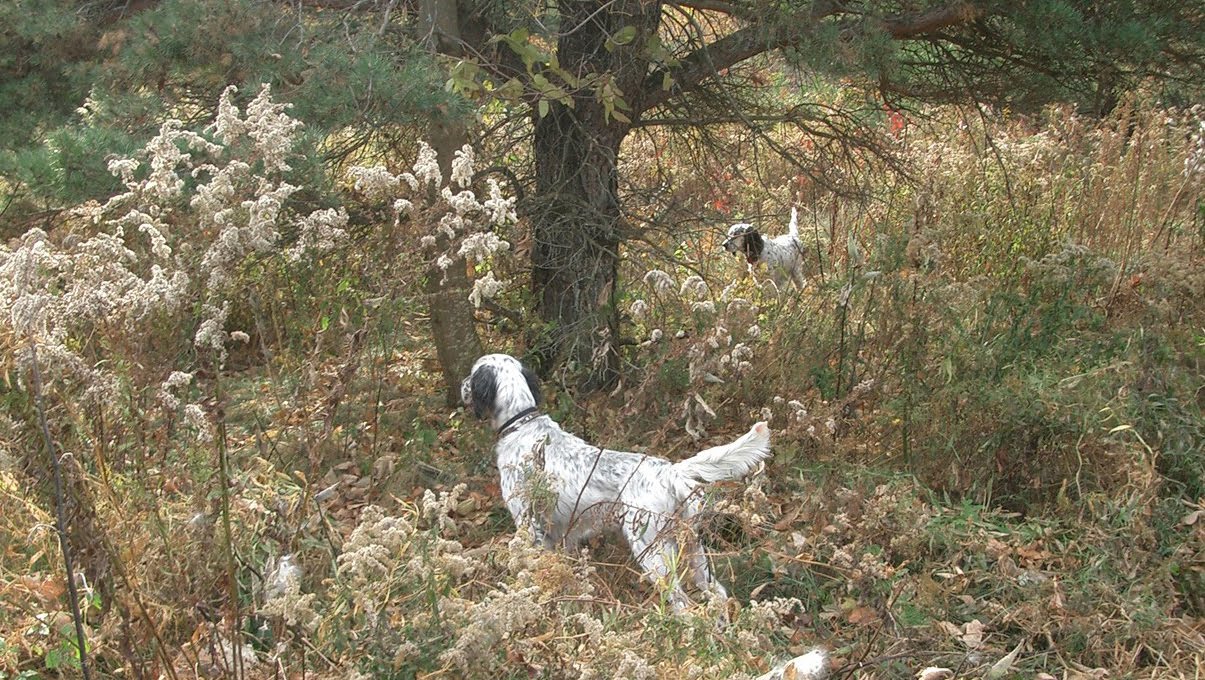We
do not shoot woodcock in the home covert, fourteen acres that lay wet at the
back of my farm. Through it crawls a lazy creek that the beaver jam every year
or so with housing projects my Amish farmer wrecks with his backhoe.
We
planted black alders along that creek in 1988, trees that have been cut over
twice, the last time in 2013. The main
stand holds bird in spring, dancers that spiral over an adjoining hayfield we
call the Goose Pasture. Last year was
our best yet for staging birds on the move in autumn, the dogs pointing resting
woodcock across the entire plot.
So
the home covert is part woodcock preserve, part schoolyard, conditioning for
the older dogs, the perfect place to light a fire under youngsters. Since the last cut, the alders have yet to
drown out the cane briar and black raspberry laced like concertina wire through
the understory. I follow my dogs, my
loins girded in heavy canvas chaps over jeans, camera stuffed in the armored Filson
vest that’s been missing a bottom button for twenty years. I snug tight a low profile blaze orange cap
that I will still have to pick up half a dozen times. Thick gloves I’d never
wear toting a shotgun make running camera and blank gun a challenge.
But
the only blood shed in the home alders comes from setter tail tips and hunter
forearms…foreheads…and #@%&* ear lobes. The older dogs know this covert by rote. They muscle through sharp tangles and race
along the more open fence row edge, pinning birds in places where they have
found them for years. It’s not pretty
pointing dog work, more spaniel-like rooting at times. But a hot point in a briary corner where we’ve
found woodcock for generations of pointing dogs remains as fresh and exciting
for Deacon and Doc and Lucy as it was for Arran and Captain, Cotton and Dusk,
Willie, Dinah, Molly and all the rest…and is for me.
Before
the alders were planted, the former owner of this farm rode a one-eyed white
walking horse to his woodcock and even the occasional ruffed grouse, the dogs
coming across wild birds in the thickets above broad food plots where bobwhite
quail covied. The quail were pen-reared
in isolation, live trapped and never handled.
They were skittish, flushed hard and flew fast…but they weren’t wild
birds, and the landowner used a highlighter to mark the woodcock contacts in his
game diary where he kept track of dog work and shooting.
We
took turns as horse holders and gunners.
Not always, but most times, we shot over, rather than at, woodcock the
dogs stood, not because we didn’t love the shooting or a lovely meal of
fast-seared woodcock over wild rice. We
knew even back then that the birds were in trouble across their range and eventually
consecrated the farm as sanctuary for them.
These
days, the horses are saved for other times and places, and we take Shank’s Mare
into the alders. Even the puppy, the
irrepressible Firelight Cool Hand Luke, takes a turn down one section that
isn’t quite so gnarly, gamboling and snuffling and dinking about until I fly a
big racing pigeon from the shoulder bag of loft birds I carry just to make sure
there are no dry runs. As the dark bird
batters its way up and out of the alders, it’s almost like a cartoon electric
charge runs all through the puppy; when
he chases, I squat to shoot the .22 blank gun into the ground, muffling its
sharp report. Every release adds purpose
to puppy putzing and gets us closer to the time when a woodcock cooperates and
holds upwind. When that moment comes, point
or push, it doesn’t matter. It’s a wild
bird contact, another chance to ignite his Firelight blood toward a gun dog
fever from which I hope neither he nor I ever recover.
- Randy Lawrence










